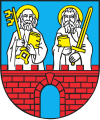 Alternate name: Striegau [Ger]. This town in Świdnica County, Lower Silesian Voivodeship in SW Poland is the seat of the administrative district called Gmina Strzegom, 15 km (9 mi) NW of Świdnica and 52 km (32 mi) W of the regional capital Wrocław. 2006 town population was 16,782. During World War II, Nazi Germany used the town as a subcamp of the nearby Gross-Rosen concentration camp. After 1945, the Potsdam Conference made Strzegom part of Poland. [July 2009]
Alternate name: Striegau [Ger]. This town in Świdnica County, Lower Silesian Voivodeship in SW Poland is the seat of the administrative district called Gmina Strzegom, 15 km (9 mi) NW of Świdnica and 52 km (32 mi) W of the regional capital Wrocław. 2006 town population was 16,782. During World War II, Nazi Germany used the town as a subcamp of the nearby Gross-Rosen concentration camp. After 1945, the Potsdam Conference made Strzegom part of Poland. [July 2009]
Normal 0
Documentation shows Jewish settlement since 1350. At the beginning of the 15th century, 73 Jews were killed in Anti-Semitic riots. In 1454, they were accused of profanation of the Most Holy Sacrament and expelled. In 1455 the synagogue, built in the 14th century, was converted to the Catholic Church of St. Barbara on Koscielna Street. In 1812, King Frederik Wilhelm III proclaimed an emancipation edict after which Jews began to re-settle in Strzegom. In 1842, they established a kahal subject to Swidnica. Granite from local quarries and a railway connection with other cities of Lower Silesia spurred development. 29 Jews lived there in 1849 and in 1880, 140 Jewish inhabitants. An independent kahal existed in the mid-19th century. Jewish population: 228 in 1856, 609 in 1857, 656 (31%) in 1884, and 672 (74%) in 1921. Many were Chassids with a conservative, traditional way of life that in the interwar period became increasingly supportive of Zionism. In 1936, the Nazis dissolved Jewish community. Three years later only 6 Jews remained. In January 1940, the Nazis deported some of them to Stoczek, now a small village in the gmina Węgrowski with a population of about 900 with a central market. About 200 young Jews deported to forced labor camps. Liquidation of the ghetto took place on September 22, 1942 with the populace murdered in nearby Treblinka although some were murdered in the village. During WWII, a work camp for Jews was set up in Strzegom. In 1944 all prisoners were transported to Bergen-Belsen. [July 2009]
CEMETERY: Established in 1815, earlier burials took place at the cemetery in Swidnica. The 0.07-ha cemetery on St. Jadwiga Street in the corner of the destroyed Evangelical cemetery is surrounded with wall and locked entrance gate with a padlock although the cemetery is accessible from the park side where part of the fence is destroyed. In the 1990s, the area was cleared, but now is hardly visible. The cemetery is completely overgrown and littered. Few matzevot are visible. One post-war gravestone is in very good condition. Single foundations of gravestones are visible. More matzevot may remain in the overgrowth. From the street side part of the cemetery stone wall is visible. Photos. video. [July 2009]
CEMETERY: photos. [July 2009]
US Commission No. POCE000510: In Walbrzych. The US Commission is not finished rechecking this file. [2000]
